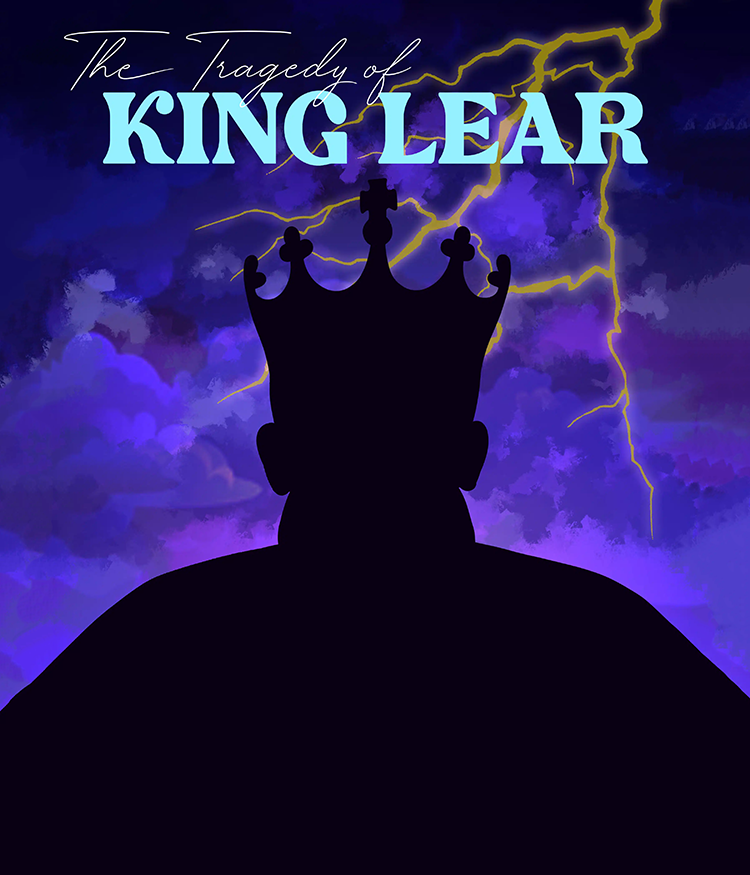
King Lear, by William Shakespeare
Directed by Paul Mullins
A play that explores how the craving for power can shatter both kingdoms and families, King Lear paints a chilling picture of the plight of humanity in an indifferent universe and charts a monarch’s disturbing descent into madness. Featuring some of the most powerful and harrowing verse that Shakespeare wrote at the height of his powers, this powerful tale will star former Shakespeare Santa Cruz Artistic Director and Royal Shakespeare Company actor Paul Whitworth in a not-to-be-missed tour-de-force performance.
Benefactors
Kathy Kenan & Alan Daniel
The Towell Family Fund
Executive Producers
Yong Bai
Joanna Miller
King Lear
Paul Whitworth*
Goneril, his eldest daughter
Paige Lindsey White*
Regan, his second daughter
Kelly Rogers*
Cordelia, his youngest daughter
Yael Jeshion-Nelson
Duke of Albany, husband to Goneril
Rex Young*
Duke of Cornwall, husband to Regan
Charles Pasternak*
Earl of Gloucester
Derrick Lee Weeden*
Edgar, his elder son
Junior Nyong’o*
Edmund, his younger bastard son
M.L. Roberts*
Earl of Kent
Patty Gallagher*
Fool, attendant on Lear
Sofia Metcalf*
King of France
Jono Eiland
Duke of Burgundy, a suitor to Cordelia
Jeremy Helgeson
Oswald, servant to Goneril
Allie Pratt
A Doctor
Peter Hadres
Soldiers, Servants, Messengers
Miles Blue, Jono Eiland, Mariana Garzon Toro,
Cayden McCoy, Peter Hadres, Jeremy Helgeson
Director
Paul Mullins++
Assistant Director
Rebecca Haley Clark
Scenic Designer
Michael Schweikardt+
Costume Designer
B. Modern+
Lighting Designer
Marcella Barbeau+
Sound Designer/Composer
Barry G. Funderburg+
Wigs Designer
Sharon Ridge
Properties Master
Thomas Bigley
Stage Manager
Jessica C. Bomball*
Head of Dramaturgy
Sean Keilen
Dramaturg
Ariane Helou
Textual Consultant
Michael Warren
Voice & Dialect Coach
David Morden
Fight Choreographer
Dave Maier
Assistant Stage Manager
Max Zamorano
Assistant Costume Designers
Gillian Bong, Wendy Lynn
Directing Intern
Addison Saltz
Stage Management Intern
Bette Vajda
Dramaturgy Intern
Olivia Merryman
* Denotes member of Actors’ Equity Association, the union of professional actors and stage managers in the United States.
+ + The Director is a member of The Stage Directors and Choreographers Society, a national theatrical labor union.
+ These Designers are represented by United Scenic Artists, Local 829 of the International Alliance of Theatrical Stage Employees.
King Lear is Shakespeare’s masterpiece. A family drama with epic scope, synthesizing the personal with the political. A beautiful, terrifying journey through our distinctly human need for control and our anxieties surrounding the process of aging. I am so happy to welcome you to the Grove to experience this story again or for the first time. We have an incredible company of actors, designers and support crew telling the tale. They are led by the great Paul Whitworth as Lear. The world of the play is a bleak and violent one, but one of the things I love about this play is its relentless search for meaning, affirmation, and renewal – and how even in despair we can find glimpses of beauty and moments of grace.
Paul Mullins
King Lear was written sometime between 1603 and 1606, years when the plague regularly swept through England and Europe. In our own pandemic era, Lear continues to resonate because it seems most cannily to echo our experience (and perhaps Shakespeare’s) of a plague-ridden world: time out of joint, families and nation splintered. Lear – isolated, severed from himself, raging at hurricanoes and howling with grief – embodies a very 2020 frame of mind. No wonder the legend of Shakespeare writing King Lear during a plague breakout became a viral meme in the early days of COVID lockdown, echoing our experience of an overturned world order while also inviting us to channel the anxieties of the moment into artistic creation.
The first recorded performance of Lear took place on December 26, 1606 at the court of King James I, and the playhouses had indeed been closed earlier that year due to plague. As a reflection of the anxieties of its day, however, King Lear is more preoccupied with power: its embodiment, retention, dissemination and transfer. The question of succession had been a pressing one during the reign of Elizabeth I, the “Virgin Queen.” Now, the ascension of James I introduced a new royal family, reframing the question of generational stability and transfer of power. Lear’s earliest audiences might have found its premise – of a king deciding his children’s inheritance – newly relatable given that, for the first time in nearly fifty years, England’s monarch had children. King Lear presented James I and his court with an object lesson in how a royal family’s internal strife could threaten national stability.
Yet if the tragedy was meant as a cautionary tale, James was already aware of some of its lessons. The story of Lear was recorded in the 12th century by the Welsh historiographer Geoffrey of Monmouth, whose History of the Kings of Britain includes the tale of Leir, an ancient King of the Britons, who divided his kingdom among his three daughters. In this account, Leir descends from Brutus of Troy, legendary first king of Britain (himself a descendant of Aeneas, the mythical founder of Rome). Upon his death, Brutus divided his kingdom among his three sons: to Locrinus was bequeathed the territory that came to be known as England; to Albanactus, Scotland; to Camber, Wales. James I was only too well aware of this origin myth for the struggles for autonomy among Britain’s peoples. While King of Scotland, in 1599 he published Basilikon Doron (The Royal Gift), a treatise on government dedicated to his eldest son. In it, he wrote: “If God send you succession … make your eldest son Isaac, leaving him all your kingdoms; and provide the rest with private possessions: Otherwayes by deviding your kingdoms, yee shall leave the seed of division and discord among your posteritie.” Four years later, James inherited the English crown and England and Scotland were unified under his rule, thus raising the question of whether his heir(s) would sustain this union or divide the kingdom once more.
BEFORE THE PLAY BEGINS
Lear, the long-reigning King of Britain, has three daughters. The elder two, Goneril and Regan, are married; the youngest, Cordelia, has a number of royal suitors. Lear is ready to settle the question of their inheritance.
Ariane Helou
Check out the list of flowers planted in our Shakespeare Garden. Each flower corresponds with texts from Shakespeare's plays. Special thanks to Lawrence G. Van Velzer & Peggy Gotthold with Foolscap Press.










